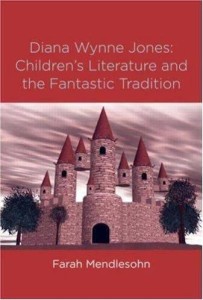 Kestrell Rath penned this review.
Kestrell Rath penned this review.
Diana Wynne Jones (DWJ to her fans) is one of those writers who, despite the fact that she is frequently referred to as a “children’s author,” has a significant following of adult readers. Although there are an increasing number of literary critics addressing the subject of children’s and young adult fantasy, there is still a lack of literary criticism addressing why those books often shelved in the children’s sections of bookstores and libraries hold such a strong appeal for so many adult readers. Despite the title of this book (a title chosen by the publisher, not the author), its subject is a sophisticated exploration of Diana Wynne Jones’s complex approach to writing and storytelling.
Mendlesohn’s thesis is that Diana Wynne Jones’s has consciously created a literary style which is intended to entice readers to not only read but reread her stories, and to use their readings of those stories as a means of interpreting and critiquing other works in both fantastic and realistic fiction. The core of Mendlesohn’s criticism focuses upon how DWJ’s fiction (which often includes parodies and playful caricatures of clichés in fantasy fiction) along with her non-fiction writing on the subject of fantasy literature (such as her award-winning The Tough Guide to Fantasyland, reissued in 2006 in the USA by Firebird Books), represents a body of criticism produced by Jones herself on the uses of fantasy.
It is Jones’s critical stance toward writing and, in particular, writing fantasy, which Mendlesohn sets out to unpack in her own book. Each of the seven chapters explores a specific trope or element of Jones’s writing, such as time travel, knowledge as agency, and the ways in which fantasy worlds can be made to complicate if not critique assumptions about how the “real” world works. Mendlesohn develops these ideas by creating constellations of connections to other works. If I have any criticism of Mendlesohn’s style of writing in this work it is that the quicksilver connections she makes left me sometimes having to go back and reread in order to follow the thread of her thoughts. Mendlesohn herself states, however, that she never intended this work to provide a thematic approach, and the result often leaves the reader feeling as if she is participating in a long late-night conversation on Diana Wynne Jones as a favorite author and the imaginative appeal of fantasy literature in general.
Mendlesohn explores how Jones turns many of the tropes of fantasy which have become clichés — the map, the learned guide, the lost heir, even the happy ending — inside-out in order to challenge the traditionally conservative “lessons” at the core of many fantasy stories. Mendlesohn’s genius is for revealing the hidden underpinnings of fantasy literature without having the process feel like mere dissection, as when, during her opening discussion of definitions of fantasy, she maps out the basic critical questions she wants to address in the book:
Any consideration of the narrative strategies of different fantasies needs to focus on three basic but critical questions: how the texts become fantastic, what the consequences of the text becoming fantastic are for the position of the reader within the text, what the consequences are for the construction of that text in terms of the language used, and the political consequences of the telling of the story.
This last aspect of Jones’s work supplies one of the richest veins in Mendlesohn’s examination of Jones’s writing, namely, that not only does Jones subvert the genre expectations of children’s books as “social issues” books, but, as in the works of E. Nesbit and Joan Aiken, fantasy is used subversively as a mode of challenging the assumptions embedded in realistic fiction, with its emphasis on didactic modes of teaching by defining knowledge rather than allowing readers to make inferences and discovering other imaginative ways of interacting with the story.
It is difficult to think of a critic and scholar more qualified than Mendlesohn to lead us through such an examination of Jones’s work. Mendlesohn is both an award-winning scholar of science fiction and fantasy and the maintainer of The Intergalactic Playground, a Web site which provides reviews of young adult fantasy and science fiction. Mendlesohn’s familiarity with both fantasy literature and its literary criticism is truly impressive, and her unpacking of the often dense literary debates which have arisen around the purposes and reception of both children’s and fantasy literature helps illuminate cultural attitudes toward the many purposes of writing and reading fantasy.
Mendlesohn has written a text which is both scholarly and accessible to a wider audience. The entire text is only two hundred and eighty pages and consists of seven chapters, plus an excellent introduction and an epilogue. For the DWJ fan who wants to dive deeper into Jones’s writing and is willing to navigate some degree of literary criticism, this invaluable text is certain to instill the desire to go reread all of her favorite DWJ stories. However, while Mendlesohn’s prose is clear and concise, the level of literary analysis she employs in this work means that this is probably not the book for general readers who are looking for a quick overview of Jones works or her literary career.
For those scholars looking for a text which outlines some of the basic questions regarding children’s fantasy, this book, with its outstanding bibliography, is an excellent place to begin. Also highly recommended for anyone who teaches on the subject of children’s literature, including librarians who specialize in YA fantasy. Mendlesohn’s extensive bibliography also provides a robust source for any reader or scholar who wishes to learn more about the literary criticism of fantasy.
(Routledge, 2005)
